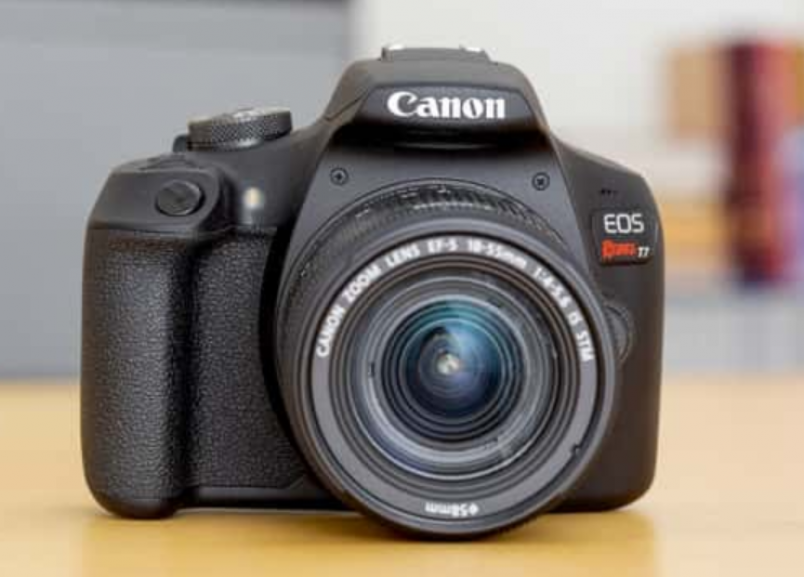
PROS
- 24MP image sensor.
- On-screen shooting guide.
- Raw support.
- Sharp LCD.
- Wi-Fi-enabled.
- Inexpensive.
CONS
- Fixed rear LCD without touch input.
- Dated image processor limits high ISO capture.
- Autofocus not available when recording video.
- Slow 3fps burst rate.
BOTTOM LINE
- Canon’s EOS Rebel T7 SLR camera features an upgraded image sensor, but is still way behind the curve in other areas.
Canon has finally put a modern 24MP image sensor in its least expensive SLR. But the EOS Rebel T7 ($549.99 with 18-55mm f/3.5-5.6 IS II lens) doesn’t offer any other significant updates from its predecessor, the T6, and remains a woefully dated SLR when compared with more modern alternatives, from both Canon and its competitors. Skip this half-baked upgrade and spend your money on a better entry-level SLR or mirrorless camera. The Nikon D3400 is a better camera that sells for about $500 with a lens, and if you spend a little bit more you can get one of our Editors’ Choice options, the mirrorless Sony a6000 ($649 with lens) or the next model up in Canon’s line, the Rebel T7i ($899 with lens).
Design: Not Much New Here
The T7$499.99 at Canon has the same body as the T6$399.00 at Amazon. It measures 4.0 by 5.1 by 3.1 inches (HWD) and weighs 1.1 pounds without a lens. It doesn’t deviate from the SLR design paradigm in any way. The body is finished in black, with a modest handgrip, integrated pop-up flash, and a hot shoe atop the optical viewfinder.

Like the T6, the T7 is hard bundled with the EF-S 18-55mm f/3.5-5.6 IS II zoom lens. As with the rest of the camera, the lens isn’t new—the EF-S 18-55mm f/4-5.6 IS STM, bundled with models like the T7i and SL2, is the latest iteration, two generations newer than the T7’s bundled zoom.
Aside from the lens release button, there are no controls on the front plate. The Mode dial, power switch, flash release, control dial, and shutter release are on the top plate. The shutter release is the most forward, sitting at an angle on the top of the handgrip.

Rear controls are all to the right of the fixed LCD. The Live View button is just to the right of the viewfinder, and below it you get the EV compensation, Q, Display, Menu, and Play buttons. There’s also a four-way button arrangement to set ISO, AF, White Balance, and the Drive mode, with the Set button at its center. Finally, there are two buttons at the top right corner that are used to zoom in and out of images during playback, with the zoom out button doubling as a focus point selector.
The LCD is a 3-inch fixed panel without touch support. It’s the same 920k-dot design used by the T6, sharp enough for image review and Live View. But it’s not nearly as useful as the vari-angle touch screen Canon puts in the T7i.

Lack of touch makes the camera feel like a remnant from yesteryear. Especially since Canon’s on-screen “Q” menu system is so easy to navigate on models with touch support. I found it frustrating to tap on it to change a setting on more than one occasion.
Wi-Fi and NFC are included. You can use it to transfer images to your Android or iOS device using the Canon Camera Connect app, a plus for sharing images on social media when away from home. There’s no Bluetooth, nor do you get the more advanced wireless functions available in more recent Canon cameras, like the wireless desktop transfer available with the mirrorless EOS M50.

You also get a 2.5mm interface for a wired remote control, mini USB, and mini HDMI. The T7 supports SD, SDHC, and SDXC memory, which is in the same compartment as the battery. The battery powers up outside the camera, in an included wall charger. Battery life is solid, with a 500-shot CIPA rating when using the optical finder. It drops to 240 shots when using Live View.
Performance: Underwhelming
The T7 uses the same 9-point autofocus system as the T6 before it. It takes about 0.6-second to power on and capture an image. Focus locks in 0.1-second in bright light, but slows down to about 0.6-second in dim conditions. Subject tracking is available—you need to set the focus mode to AI Servo to turn it on—as is burst shooting, but at just 3fps. The Sony a6000 runs circles around it with 11fps subject tracking.

The shooting duration varies based on your file format. If you shoot in JPG mode, the T7 captures a solid 76 photos before its buffer fills. But if you’re a more advanced photographer and want to shoot in Raw format, you’ll get just 10 shots, and only six in Raw+JPG, and you’ll have to wait about 15 seconds to clear the buffer and commit all images to a memory card.
Live View focus is painfully slow. In bright light it requires about 1.4 seconds to lock focus using the rear display, and in dim light I clocked it at 5.7 seconds on average. This lag is unacceptable in a camera released in 2015, and no, that’s not a typo. If you step up to any other current Canon SLR you’ll enjoy Live View focus performance that is almost as quick as through the viewfinder.
Image Quality: A Bright Spot
A camera is meant to capture images, which is one thing the T7 gets right. The 24MP image sensor puts it on the same level as the competition, even if the image processor that powers it is an older one. Images from our ISO test scene show that the T7 delivers crisp, clear JPGs through ISO 1600. There’s a slight blur at ISO 3200, the top setting at which noise is less than 1.5 percent, and more significant blur at ISO 6400. ISO 12800 is the top setting, but you’ll need to dive into a menu to turn it on, and enable it manually when you want to use it—automatic adjustment tops out at ISO 6400.

If you do shoot in Raw, the T7 captures crisp images without too much grain through ISO 3200. At ISO 6400, detail holds up well, but grain is stronger. You can’t go any higher in either Raw or JPG format, a limitation of the image processor. The T7i and SL2 both support ISO 25600 capture, useful when the light is very dim.
Video: Where’s the Autofocus?
Video tops out at 1080p, with 24fps and 30fps frame rates available. Video quality is fine—not the best 1080p I’ve seen, but by no means the worst. Nobody is going to use the T7 and expect to get pro results—there’s no microphone input for one thing, a must-have for serious videographers, most of whom will want a camera with 4K.

But more casual users will want a camera that can keep a scene in focus while recording video. The T7’s autofocus system can set focus before you start recording a clip, but it does not function when the camera is rolling. You can adjust focus manually, but the SL2$549.00 at Amazon and the T7i have video autofocus that’s quick, smooth, and easy to use—if you want to record video, they are much better options.
Conclusions: Better Ways to Spend Your Money
Like the T6 that came before it, the T7 is a disappointing, underwhelming entry-level model from a trusted brand. Canon knows how to make a good camera, and with a few refinements the T7 could be one. But it’s too far behind other models. If you want an affordable, entry-level SLR, the Nikon D3400$496.95 at Amazon is better all around, and it doesn’t cost as much. Its image quality is a bit better and it can autofocus when recording video, although not as smoothly as a Canon SLR or most mirrorless cameras.
If you’re committed to the Canon brand, the SL2 and the T7i are both much better cameras, though they are a little pricier. The Sony a6000$548.00 at Amazon is a solid mirrorless choice, delivering strong image quality and speedy focus in a smaller form factor.
It appears as if Canon has opted to rest on its laurels with the T7, which is a shame. Customers shopping should be able to trust that the number one name in cameras delivers a product that is at least competitive with other entry-level SLRs and mirrorless cameras. No one expects low-cost choices to perform like pro cameras that sell for much more, but they should at least be in the same ballpark as similarly priced alternatives. That’s not the case with the T7.
Source: pcmag.com









































